The second wave that covered us. The standard that was waiting
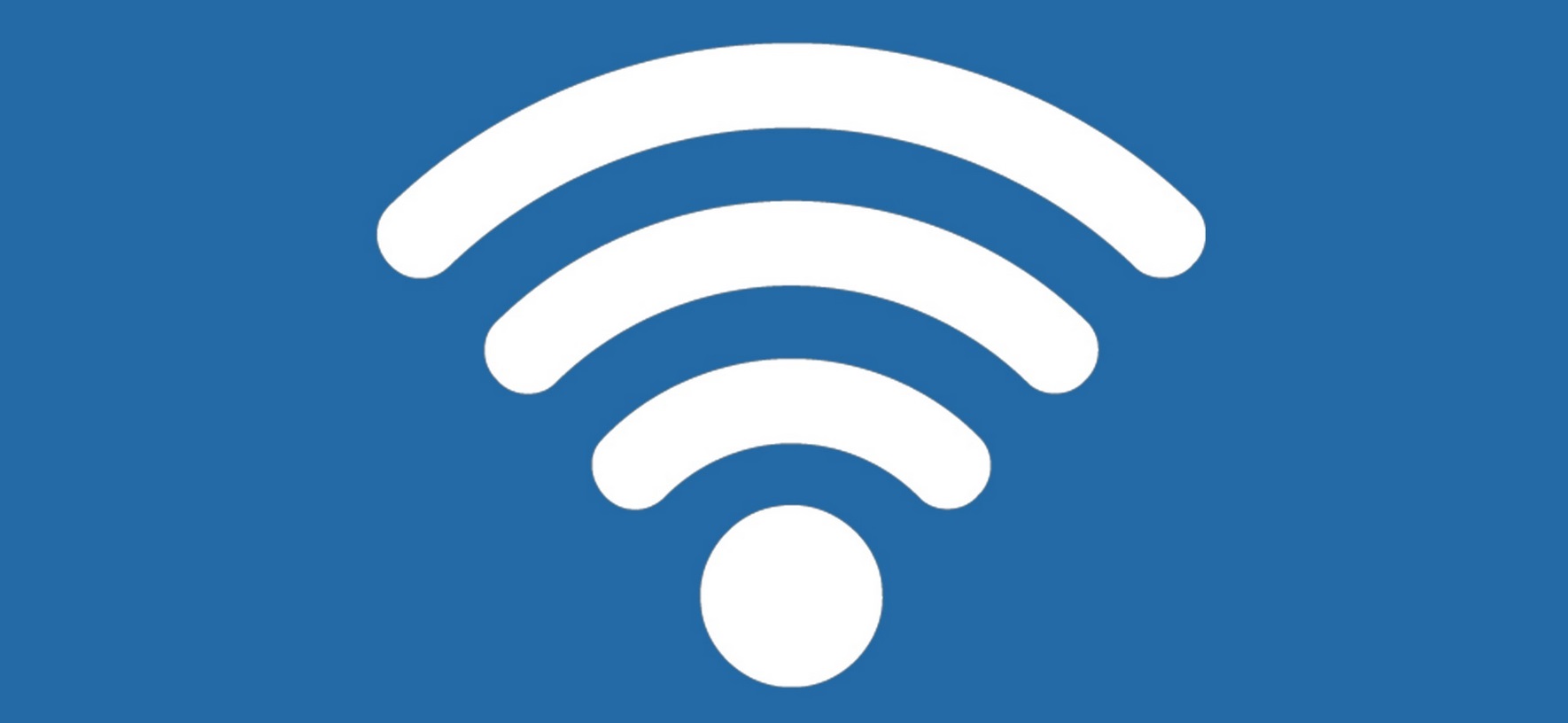
Before writing about the waves, let's talk about the source that generated them. In this context, it is the standard for wireless LAN 802.11ac, which is an evolutionary iteration of the previous standard 802.11n, partially compatible with it. Partially, because, as we will learn later, it only works on the 5 GHz frequency range. 802.11n, as you know, worked on both bands - the pure licensed 5 GHz band, and the 2.4 GHz band - not a dying camper, a hotbed of frequency interference and a limited factor of reizing (reuse of frequency channels within the same location or wireless domain). The development of the standard in the form of the first editions began in 2011, and then the pioneers of the WIFI alliance began to produce the first chipsets for the new wireless standard, striving not for progress, but for enrichment. Going through the pangs of birth and becominghere ).
The idea of the new standard was based on the same manilism that people started to hurt when developing the 802.11n standard - the idea of a wireless office, when noble people in white clothes with ipads in their hands, lying on the lawn of their native campus, rule the world. But either the nobleness of the broad masses of the problem, or the idea itself was not favored by higher forces, so I managed to achieve such organicity and identity with my own only a few. The office IT world is still ruled by the devil of copper and quartz mines and their minion - the small demon RJ-45. Many creative individuals will disagree and say that WIFI will be deployed everywhere in their offices. And they will be right in some ways. But this doesn’t correspond to the very idea of a wireless office - clean and unclouded. Checking the arguments is easy:
Only far away in the high valley of Silicon Valley, the Brahmins of the Apple sect achieved such enlightenment to the envy of everyone. Well, or we think we have achieved. In any sect, the main thing is not to know, but to believe!
Description, differences
It all started well. One of the application goals for developing the 802.11ac standard was to exceed 1Gb / s wired Ethernet speed. The Cisco Systems illustration below shows graphically the evolution of wireless standards from the first releases to the present. Note that the PP is a spatial stream, and the numbers are the values of the protocol speeds (or throughput) of the standards.
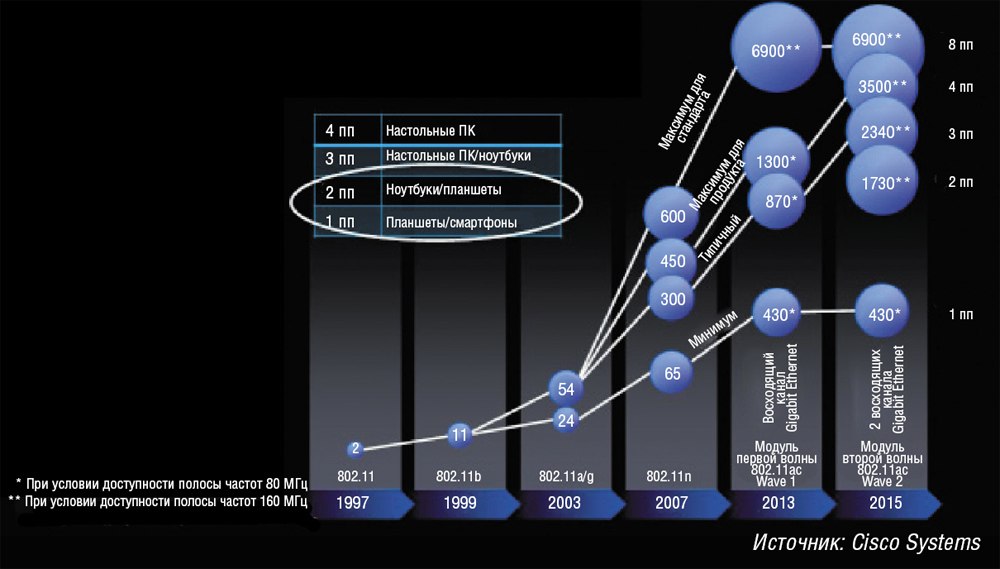
Fig. 1
It is well shown here that there is a maximum in bandwidth, which is theoretically achievable within the framework of the standard, but in practice it is converted to the value that the manufacturer of wireless equipment provides us. This is the first bell about the mismatch between the desired and the real. However, the first wave of the 802.11ac standard stated that it had crossed the 1Gb / s milestone. Pay attention to the plate in the upper left corner, where mobile devices with wireless connection are described and the characteristics of their wireless modules - 1PP, 2PP and so on. That is, depending on how many spatial streams the wireless module of a typical mobile device can work with, it will receive the value of bandwidth that the corresponding standard offers. As can be seen from the figure, a bandwidth of 1300 Mb / s may be possessed by a device in which the wireless module forms 4PP. This is the second speed limit within the standard for different classes of mobile devices. The second, but not the last, as we will see later. The maximum theoretical speed of the 11ac wave2 standard - 6900 Mb / s at 8pp speaks more about the potential and serves in the marketing support of the standard than about the actual implementation. It is unlikely that wireless clients will be able to support 8 PPs in the near future, although this is defined by the standard. The maximum theoretical speed of the 11ac wave2 standard - 6900 Mb / s at 8pp speaks more about the potential and serves in the marketing support of the standard than about the actual implementation. It is unlikely that wireless clients will be able to support 8 PPs in the near future, although this is defined by the standard. The maximum theoretical speed of the 11ac wave2 standard - 6900 Mb / s at 8pp speaks more about the potential and serves in the marketing support of the standard than about the actual implementation. It is unlikely that wireless clients will be able to support 8 PPs in the near future, although this is defined by the standard.
As we now know, the 11ac standard went around the world in two stages, in two waves of releases and products - wave1 from 2011 (releases, drafts) to 2013-15, and the second wave 2 from 2015 to the present . Why is that? Everything is very simple. The specification of the 802.11ac standard claims many technical innovations and manufacturers throw products on the market without waiting until they can realize all of them in the metal. Market laws have not been canceled. Nowadays, we live in a situation where there are wireless devices on the market that operate in wave1 and wave2 implementations. Whether there will be a third and subsequent waves is an open question. Probably not. By the way, it should be noted that devices of the standard 802.11ac wave1 do not understand the functionality and additions of the second wave.
We continue. Due to what the standard reaches such speeds, what is the difference from the standard 802.11n, and how is the second edition of the standard different from the first? Below in Fig. 2 is a table for a better comparison of parameters (again from the Cisco website).
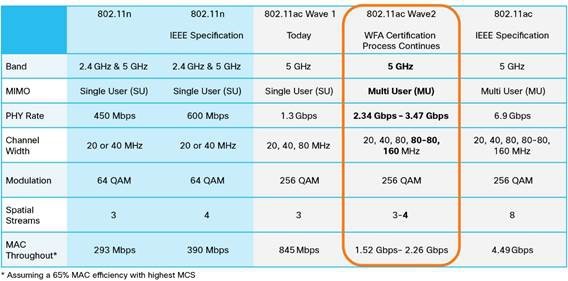
Fig. 2
So, the main difference between the 11ac standard and the previous ones - it found the strength to part with the 2.4 GHz frequency range, comfortably located in the 5 GHz range. The advantages of the "five" are well known to everyone for a long time - low noise, a greater number of non-overlapping channels for use, fast attenuation when passing both in an open environment and through obstacles. This, oddly enough, has more advantages for building high-density networks with a large capacity, in contrast to networks created by the criterion of a larger coverage area.
Further, unlike 11n, channels with a width of 80 MHz appeared in wave1 and 160 MHz in wave2 edition (see Fig. 2). The transmission density per unit time increased - the quadrature amplitude modulation index increased to QAM 256.
The use of new chips allowed to increase the duration of wireless devices due to more economical use of energy in each cycle of information transfer and faster transfer of a unit of information.
The number of spatial streams has increased - up to 8PP in the standard, the current one implemented in wave2 is 4PP (in wave1 3PP, if anyone forgot).
And the main feature inherent only to wave2 devices is MU-MIMO (MultiUser - Multiple input multiple output). In fact, this is the simultaneous operation of an access point with several wireless clients at once. Unlike previous standards, when data was exchanged with only one device at a time, the standard allows simultaneous operation with four devices, with the number of spatial streams 8PP (for all clients in total). But one client, at the moment, cannot accept more than four spatial streams. Note also that a point can only transmit data to four devices at the same time, but not receive them from them. The uplink works as usual - one device transmits data to the access point at one time. Of course, for such multi-user work, the 802 release. 11ac wave2 should support not only points, but also clients. The wave1 client will not be able to work in multi-user mode with the wave2 release point. And another note: a point cannot transmit more streams than it has transmit-receive antennas. That is, if there are four antennas, then there are four or fewer streams. An example of multi-user operation of the 802.11ac wave 2 point is shown in Fig. 3.

Figure 3
Another technology used in 802.11ac wave2 is beamforming. Its meaning is to form a directional diagram from a point to the client. This allows more efficient use of bandwidth for data transmission in a downlink (downlink) channel. This is not to say that beamforming is a new technology. It was already known in the market and was supposed to be used in the 802.11n standard, but never became part of the standard. Nevertheless, manufacturers proactively developed and offered it to the market. The best known implementation is the Cisco Client Link functionality.
How Client Link worked. In short, based on the reflected signals from the client, the point calculated its approximate location and formed a directional beam in its direction. And then, in the process, she analyzed the data from the client, adjusting her radiation. Such a mechanism was called implicit beamforming, since the client participated in the process in a passive way and the point used the calibration data from the usual service frames of the client to form the diagram. With Client Link 3.0, support for 802.11ac clients and its standardized implementation, explicit beamforming, have been announced.
What are the differences between a standardized edition - explicit beamforming from previous, non-standard solutions? The bottom line is that now in the process of beam formation from point to client, both the client and the point take an explicit part. A point sends sound packets (ndp - null data packet), which contain a matrix of radiation signals from each antenna of the point and phase shifts. Having accepted this matrix, the client responds with a point indicating the signal levels with which it hears the access point, forming a response matrix (directivity matrix). That is, the client sends special calibration packets to the access point in response to its request. And the access point, analyzing the information received, calculates the signal levels, phases for each antenna to form a directivity diagram for the client (Fig. 4).
A prerequisite for such a handshake is that the client must support these standards and the implementation of beamforming. It should be noted that the ability of the client to participate in the explicit beamforming procedure is optional, and not mandatory, within the framework of the standard 802.11ac wave 2. This is done for backward compatibility of the new standard with devices of the first wave and earlier standards. Thus, the second wave of the standard implies working with clients in both explicit and implicit beamforming functionality. And the general requirement for both types of beamforming is explicit and implicit, it applies only to points with omnidirectional antennas.
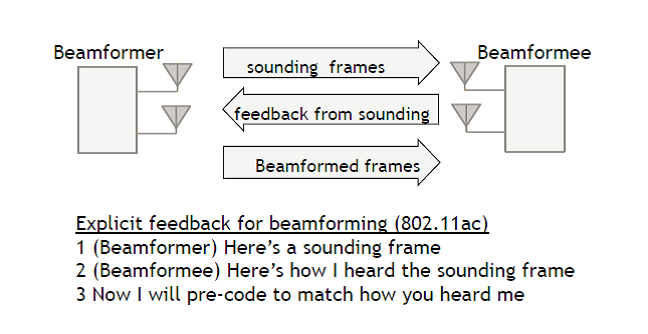
Fig. 4
To summarize. The multi-user simultaneous operation of the access point and clients within the framework of the 802.11ac wave2 standard allows us to make the network more dense (saturated with wireless clients in a limited space with work without downtime), thereby bringing us closer to the concept of a wireless office. The increased data transfer speed and large network capacity are two key achievements of the new standard, as claimed by the developers.
From beautiful far to sinful earth
What they didn’t say and what can upset: about the channels, more precisely about the frequency resource in the 5 GHz band. In the current case with restrictions on DFS channels, 160 MHz channels - as many as two can be created. Chic factor reyzinga). We look at the pictures - American and European comrades Fig. 5 and 6, respectively: Fig.
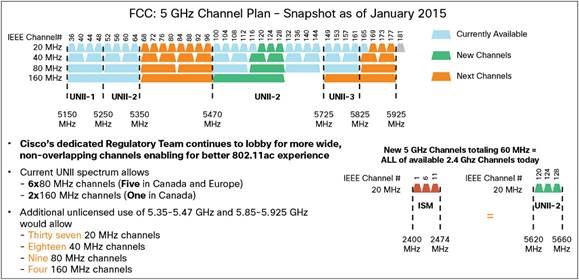
5 Fig . 6
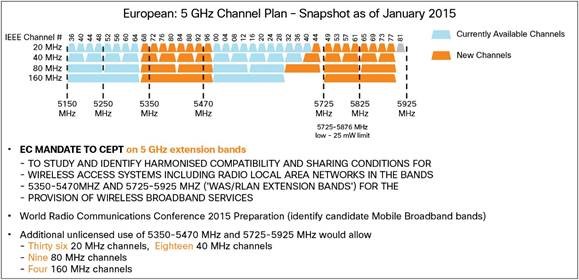
Without channels highlighted in yellow - sadness longing. Our American friends and partners, as well as the bureaucracy in Brussels, are working to ensure that there are more channels available in the 5 GHz band, despite the resistance from various weather sensors and medical equipment. Noble goal: 4-160 MHz-channel, 9-80 MHz-x, 18-40 MHz-x and already 36-20 MHz-x. The battle along the way is still ongoing. In our country, despite the fact that people look at questions broader, and with people softer, scoring sufferers on DFS, there are also so far only two possible 160 MHz channels (Fig. 7). That is, here we keep up with the entire wireless world. More precisely we limp.

Fig. 7
On the other hand, it is not rational to use 160 MHz channels in decisions on building corporate wireless networks. If we are talking about wireless networks in the concept of HD or VHD (high-density or very high-density), then for their deployment it is recommended to use channels in 20/40 MHz. This is done to minimize interference between access points, both with your own and with others, operating within the corporate wireless domain. And on a home router, you can easily use one of the two currently available 160 MHz channels and not be sad about the lack of a frequency resource.
Another point: if someone forgot, protocol speed is not real throughput at all. To understand what speeds will be maximally achievable, you need to multiply the protocol speed by 60-70% of the nominal. This will be a maximum of one device under ideal conditions. If there are many devices on the network, and they are all different - 1SS, 2SS, 3SS, and so on, then the real speed for one session will sag even more. Manufacturers have the corresponding results of test measurements of speeds in the laboratory. Figure 8 shows a summary table from Cisco on protocol and throughput rates on 80 and 160 MHz channels for clients with different numbers of supported spatial streams. Notice the MAC Throughput values in the last column.
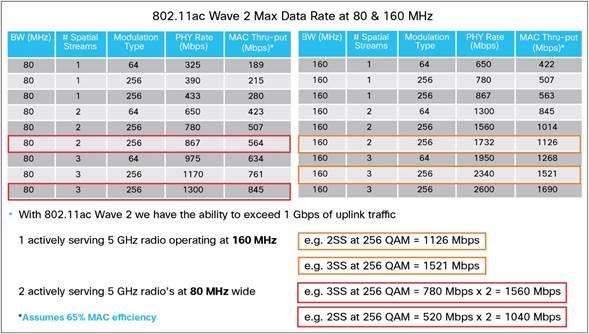
Fig. 8
But these figures are in ideal conditions. The reality is even worse - a large number of customers, a large competition for the ability to transmit, low SNR, a mix of 11n and non-MU-MIMO wave1 devices, CCI and ACI interference. In a high-density network, it is difficult to expect that at least one device will receive pure gigabit per session. So the reality is not as rosy as the sheer volume of advertising headlines.
A little more truth of life - even the work of the main feature of the second wave of 802.11ac - MU-MIMO is unpredictable, and depends on a large number of random factors:
- number of customers;
- distances to the point;
- types of customers with a difference in the number of spatial streams.
And as we know, a wireless corporate network is always heterogeneous among customers, which negatively affects the overall throughput in the network as a whole and for each specific client in particular.
What good can be learned from all this is that there is no need for a new wireless standard to upgrade the wired network segment, which rises to the access layer uplinka from new access points. Advertising says that up to 6.9 Gb / s the 802.11ac wave2 standard is overclocked and we certainly need faster wire connections to meet the new bandwidth requirements. Someone even fussed about this - Cisco, for example. They released the new line of Cisco Catalyst Multigigabit Switchingswitches that have access ports with speeds of 2.5 -5 Gb / s (standard 802.3 bz). Accordingly, the points also have such ports (for example, 38 series).
Although, if you simply analyze the real capabilities of the standard or rely on any official and not very laboratory tests of equipment , in the vast majority of installations of a corporate wireless network built on the new standard 802.11ac wave1 and even wave2, the speed per point will be lower than gigabit by almost 100 percent of cases. You can safely skip the upgrade phase to a new wired infrastructure so that manufacturers of wireless equipment do not tell you there. One gigabit per wire will be enough, at least our experience in implementation and operation 802.11ac networks indicates this.
Application and recommendations
If you are building a new network, you can completely deploy the 802.11ac wave2 network, since the prices for these points are quite affordable. Although the number of customers is still not large (wave2). But until 2018 there will be a commodity quantity (the year of the declared appearance of the 802.11ax standard).
If you are a happy owner of a network of the standard 802.11abgn, or even less so 802.11abg, then it is worth considering the option of upgrading to a new standard within the framework of both planned modernization and increased requirements, especially within the framework of the BYOD concept. And also taking into account the appearance on the market of a greater number of capricious wireless clients (iphone) working with new wireless modules. Although, of course, if you do not get enough requests for the inoperability of new devices, then the upgrade can be postponed. This is especially true for wireless networks in vertical markets such as retail and logistics.
Anyone who hurries to have access points of the first wave can well rest on their laurels, and, through appropriate software updates, enjoy life in anticipation of something more revolutionary. Here it’s rather more important than even features from the new wave of the standard, but new or licked features from a particular equipment manufacturer - band steering, clean air, optimized roaming, Smart RF and others. You can safely wait for the standard 802.11 ax. He claims to be truly revolutionary.
Well, general good wishes. If you plan to deploy an 802.11ac wave2 standard network in your office as an alternative to a wired network, it makes sense to contact professional integrators of such networks. For the question of their deployment is not boring and trivial in nature. We need the correct formation of technical specifications, analysis of the client part, calculation of network performance, conducting a radio survey at the facility, the selection of equipment - access points and AFUs, verification radio surveys and testing.
